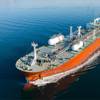Less than two weeks after Katrina made landfall, ports along the Gulf coast and channels on the Mississippi River are once again navigational and safe for ship traffic. The National Oceanic and Atmospheric Administration, the federal agency responsible for providing the nation’s nautical charts, has played a key role in a major interagency effort to ensure that navigational areas affected by Hurricane Katrina are clear of obstructions and debris.
NOAA led the surveying effort to open the region’s ports and shipping channels as soon as possible, and anticipates all needed surveys will be completed by Saturday. NOAA has survey teams in the Mid-Atlantic pre-positioned to survey shipping channels immediately after Hurricane Ophelia passes.
“Our teams have been working around the clock to help restore safe navigation channels,” said Captain Roger Parsons, NOAA Corps, who is director of NOAA’s Office of Coast Survey. “The currents of the Mississippi River are so rapid that obstructions that are identified are sometimes washed away before they can be removed, requiring our Navigation Response Teams to go back and resurvey. However, substantial progress has been made, and much of the river and ports have been reopened by the Coast Guard.”
“It requires an immense coordination between the various divisions of NOAA, the U.S. Army Corps of Engineers, U.S. Coast Guard, Navy, local port authorities, state officials and our assets on site to ensure that all critical waterways are clear,” said Parsons.
Beginning August 26 — three days before Katrina hit -- NOAA dispatched NRTs, or Navigation Response Teams, to the Gulf area in preparation for the storm’s aftermath. NOAA deployed four NRTs in the region, along with one hydrographic survey ship (Thomas Jefferson), one coastal oceanography research ship temporarily outfitted with hydrographic survey equipment (Nancy Foster), and a contract hydrographic services provider to scan the sea bottom.
NRTs, which can be quickly dispatched to emergency sites, use small survey launches equipped with side scan sonar to survey waterways for underwater hazards to vessels. When sonar detects an obstruction on the sea bottom, divers determine what it is. Sonar also provides exact water depth over the obstruction. NOAA and contract hydrographic survey ships use both multi-beam and side scan sonar, covering a broader area. Survey launches are also deployed from the ships to cover shallow areas.
Waterways must be surveyed and cleared before oil tankers, cargo ships, and other vessels can safely transit the area. In recent years, ships have gotten longer, wider and deeper, and determining precise water depths is imperative for safe navigation. Hurricanes can play havoc with the sea bottom, rendering the depths and obstructions on nautical charts obsolete.
NOAA’s Office of Coast Survey is maintaining a Web site with current information relating to post-Katrina surveys, including areas of operation and findings. Please see: http://chartmaker.ncd.noaa.gov/nsd/katrina.htm.
NOAA is using its surveying capabilities to conduct emergency scans of the sea bottom in areas identified as critical by the U.S. Coast Guard, Army Corps of Engineers and local port officials. Surveys are conducted to locate wrecked vessels and oil rigs, large debris, and shoaling that can damage or ground passing vessels.
These findings are reported to the Coast Guard, which has authority to open and close waterways, mark shipping channels with aids to navigation (buoys), and send out its daily Report to Mariners that publishes changes to nautical charts. The Army Corps of Engineers, which is responsible for dredging the Mississippi River and port areas to maintain safe depths, is removing the obstructions NOAA finds. The U.S. Navy also has dispatched salvage ships and divers to the area to aid in removal of wrecks, and check out obstructions in the extremely polluted waters. The efforts are being orchestrated through daily conference calls among agency representatives.
“We’ve focused first on opening up shipping lanes for emergency response and commercial transport to Pensacola, including petroleum shipments to the Naval base there; for coal shipments to Biloxi and Mobile power plants; and for crude and refined petroleum shipments to and from refineries and oil facilities in Pascagoula, Port Fourchon, and along parts of the Mississippi River,” Parsons said.
Kurt Nagle, president of the American Association of Port Authorities praised the NOAA survey effort in an AAPA Internet posting on September 13 and said the federal response "moved quickly and effectively to help save lives, restore services and keep supplies and commerce moving. Without the help of the public port authorities and agencies such as the Coast Guard and the Corps, NOAA and MARAD, the crucial services needed in times of crisis and the goods we depend on in our everyday lives may not be available with the timeliness that consumers and manufacturers require."
Featured videos

Inmarsat Enhances Service to Drive Digitalization

Unlock Onboard Data Efficiencies

Tracking Foreign Vessels Working in the U.S. Jones Act Market
Subscribe for
Maritime Reporter E-News
Maritime Reporter E-News is the maritime industry's largest circulation and most authoritative ENews Service, delivered to your Email five times per week









